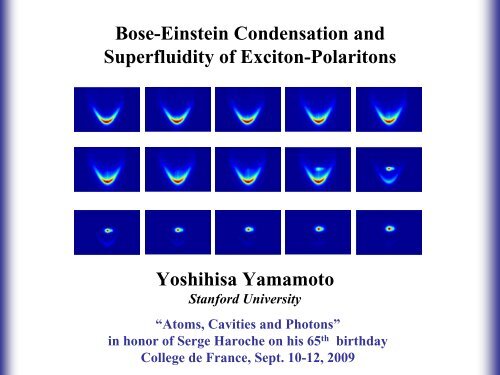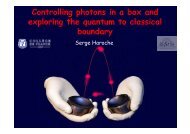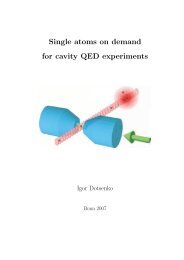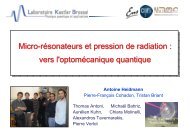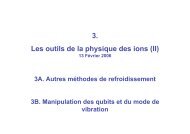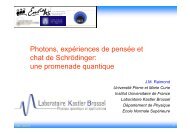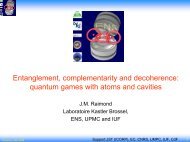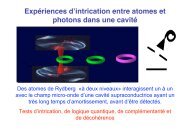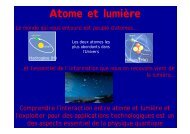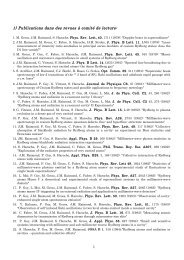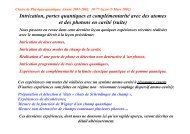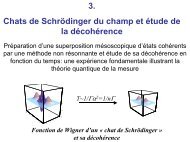Bose-Einstein Condensation and Superfluidity of Exciton-Polaritons ...
Bose-Einstein Condensation and Superfluidity of Exciton-Polaritons ...
Bose-Einstein Condensation and Superfluidity of Exciton-Polaritons ...
- No tags were found...
You also want an ePaper? Increase the reach of your titles
YUMPU automatically turns print PDFs into web optimized ePapers that Google loves.
Semiconductor Cavity QED in Weak Coupling RegimeY. Yamamoto et al., in Coherence <strong>and</strong> Quantum Optics VI ( Plenum, New York, 1989) p.1249DBRSQW in λ/2 cavityDBREnhanced conicalspontaneous emissionEnhancedspontaneous emissionInhibitedspontaneous emissionRed detuning (ω c < ω e ) On-resonance (ω c = ω e ) Blue detuning (ω c > ω e )2
Quantum Degeneracy at Thermal Equilibrium ConditionsGaAs: H. Deng et al., Phys. Rev. Lett., 97 146402 (2006)[ CdTe: J. Kasprzak et al., Nature 443, 409 (2006) ]quantum degeneracy thresholdBE distribution observed at blue detuning regime(exciton-like polariton: Δ=6.7 meV, t=40ps)T LP=4.4K, μ=−0.04 meV < BEC threshold (− 0.35 meV)Δ (meV)10 1N LP(E)10 010 -1lattice temperature0 0.2 0.4 0.6 0.8 1E LP− E LP0(meV)The experimental results are reproduced byBoltzmann-Master equation:T.D.Doan, H.T. Cao, D.B.T. Thoai <strong>and</strong> H. Haug,Solid State Commun. 145, 48 (2008)8
Spatial Coherence (Order Parameter)-Off-diagonal long range order (L. Onsager, R. Penrose, C. N. Yang)-H. Deng et al., Phys. Rev. Lett. 99, 126403 (2007)[ R. Balili et al., Science 316, 1007 (2007)]Interference Pattern through Young’s Double Slit InterferometerSolid lines:Fourier transform <strong>of</strong>the experimentalmomentum distributionTheory based onBoltzmann-Masterequation:T. Doan, H. Cao,D.T. Thoai <strong>and</strong>H. Haug,Phys. Rev. B 78,205306 (2008)9
Second <strong>and</strong> Third Order Coherence− H. Deng et al., Science 298,199 (2002)−A coherent state is all-order coherent: g (1) (0)=g (2) (0)=·····=1.A thermal state features photon bunching: g (n) (0)=n!(R. Glauber, 1963)thermal depletion+qquantum depletion-q +qg (2) (0), g (3) (0)g (3) (0)g k=0(2) (0)with scattering (BEC)k=0without scattering (laser)• Photon bunching effect due to bosonic final statestimulation observed only above threshold, whereτ pulse < τ noise is satisfied.• g (2) (0) > 1 <strong>and</strong> g (3) (0) > 1 at well above thresholdsuggests the excess intensity noise in the condensate.Third order coherence: T. Horikiri et al., in preparationTheory: P. Schwendimann <strong>and</strong> A. Quattropani,Phys. Rev. B 77, 085317 (2008)10
Outline• Recap on <strong>Bose</strong>-<strong>Einstein</strong> condensation <strong>of</strong> exciton-polaritons:MotivationE vs. k dispersionThermodynamicsCoherence• New Experiments on <strong>Superfluidity</strong>Bogoliubov excitationsMean field energy shift U(n)Universal dispersion relation E/U(n) vs. kξ(n)Quantized vortex-pairVortex-pair with pinned orientationVortex-pair with switching orientation• Future prospectsQuantum simulation <strong>of</strong> <strong>Bose</strong>-Hubbard modelsQuantum computation by BECBEC-BCS crossover11
Brief History <strong>of</strong> BEC <strong>and</strong> <strong>Superfluidity</strong>A. <strong>Einstein</strong>P.L. KapitsaL.D.L<strong>and</strong>auR.D. FeynmanA. <strong>Einstein</strong>BEC <strong>of</strong> non-interacting ideal gas(1925)P.L. KapitsaDiscovery <strong>of</strong> superfluid He (1937)London,InterpretationTisza<strong>of</strong> superfluid He interms <strong>of</strong> BEC <strong>of</strong> ideal gas(1938)L. D. L<strong>and</strong>auPhenomenological model based onexcitation spectrum (1941)N.N. BogoliubovQuantum field theory <strong>of</strong> BEC<strong>of</strong>interacting particles (1947)R.P. FeynmanAtomic theory <strong>of</strong> L<strong>and</strong>au’s tw<strong>of</strong>luid model (1955)Excitation spectrum <strong>of</strong> superfluid He12
Bogoliubov Theory <strong>of</strong> Weakly Interacting <strong>Bose</strong> Particles: RevisitSystem Hamiltonian <strong>and</strong> Gross-Pitaevskii equation:kinetic termInteraction termorder parameterBogoliubov transformation:real particlecollective excitationsDiagonalization <strong>of</strong>Excitation spectrum <strong>of</strong> atomic BECD.M. Stamper-Kurn et al.,PRL 83, 2876 (1999)Bogoliubovspectrum: mean fieldenergy shift: Bogoliubov excitation spectrum: linear dispersionat small p: quadratic dispersionat large p13
Repulsive Interaction Energy U(n)=gngE0= N2VdE0U ( n)=dN2= gn(Mean-field energy shift <strong>of</strong> the condensate)(Can be measured as blue shift <strong>of</strong> emitted photon energy at k=0=12Δωexc+g202Δ+4exciton energy blue shiftdue to exchange interaction−( g0+ Δg)2( Δ − Δω+4excreduced polariton splittingdue to phase space filling)2g 0: polariton splittingΔ: detuning parameter(=ω c−ω ex)Experiment:S. Utsunomiya et al., Nat.Phys. 4,700,2008Theory:V. Savona et al.,private communication14
Universal Dispersion Relation <strong>of</strong> Bogoliubov Excitation Spectrumin <strong>Exciton</strong>-Polariton CondensatesS. Utsunomiya et al., Nature Physics 4, 700 (2008)ε (p)E/Uat far belowthreshold(p/p th =0.001)• A: Δ=1.41 (meV), P=4P th• B: Δ=0.82 (meV), P=8P th• C: Δ=4.2 (meV), P=4P th• D: Δ=-0.23 (meV), P=24P thHealinglength:Linear dispersion at low momentum regimeSound velocity: c=dE(p)/dp~10 8 cm/s(c~1cm/s for atomic BEC, c~10 4 cm/s for superfluid 4 He)15
Energy Shift vs. Interaction Energy U in Free Particle Regime(S. Utsunomiya et al., Nature Physics 4, 700 (2008))Indistinguishable bosons Direct + Exchange terms2ˆ p + g 2 1++ +H = ∑ aˆˆ +0+ ∑ ( 2 ˆ ˆ p + ˆ ˆ + ˆ ˆpa p N gn apa apa−)2 2 2− papapm Vpp ≠ 0Energy shift for condensate particleU=gn 0Energy shift for non-condensed particleadditionalU=gn0Untrapped systemTrapped system(5-7microns)E B-E LP(meV)10.1A BC DE B −E LP =2UE k(P>P th)-E k(PaP th)=2UE B-E LP(meV)10.1E FG HE B −E LP =2U0.1 1Interaction energy U (meV)0.1 1Interaction energy U (meV) 16
Outline• Recap on <strong>Bose</strong>-<strong>Einstein</strong> condensation <strong>of</strong> exciton-polaritons:MotivationE vs. k dispersionThermodynamicsCoherence• New Experiments on <strong>Superfluidity</strong>Bogoliubov excitationsMean field energy shift U(n)Universal dispersion relation E/U(n) vs. kξ(n)Quantized vortex-pairVortex-pair with pinned orientationVortex-pair with switching orientation• Future prospectsQuantum simulation <strong>of</strong> <strong>Bose</strong>-Hubbard modelsQuantum computation by BECBEC-BCS crossover17
Observation <strong>of</strong> Vortex-Pairs in <strong>Exciton</strong>-Polariton Condensatesusing Michelson InterferometerBEC-BKT crossover in a 2D system:Key: Macroscopic phase stabilization by formation <strong>of</strong> vortex-pairsA. Posazhennikova, Rev. Mod. Phys. 78, 1111 (2006) <strong>and</strong> refs in it.Atomic BKT phase study based on population <strong>of</strong> free vortices:Z. Hadzibabic et al., Nature 441, 1118 (2006)Polariton free vortex pinned to crystal defects:K.G. Lagoudakis et al., Nat. Phys. 4, 706 (2008)phase distributionmeasurementvisibility measurement18
Phase Mapping for Vortex-Pair with Pinned Orientationanti-vortexPhase distribution (Theory)vortexInterference pattern (Theory)cf. free vortexfoldedRotation <strong>of</strong> the phase by 2π around a vortex, <strong>and</strong> by -2π around an anti-vortexPhase distribution (Experiment)cdInterference pattern (Experiment)Vortex – antivortex distancehealing lengthsubtractconstantphase slope19
Phase Mapping for Vortex-Pairs with Switching OrientationsIf the vortex <strong>and</strong> anti-vortex can flip mutual positions from shot to shot, areas withπ-phase shift <strong>and</strong> surrounded by the minimum fringe visibility should be still observed.TheoryExperimentfolded between vortex<strong>and</strong> anti-vortexexact cancellation 2017
Outline• Recap on <strong>Bose</strong>-<strong>Einstein</strong> condensation <strong>of</strong> exciton-polaritons:MotivationE vs. k dispersionThermodynamicsCoherence• New Experiments on <strong>Superfluidity</strong>Bogoliubov excitationsMean field energy shift U(n)Universal dispersion relation E/U(n) vs. kξ(n)Quantized vortex-pairVortex-pair with pinned orientationVortex-pair with switching orientation• Future prospectsQuantum simulation <strong>of</strong> excited states in <strong>Bose</strong>-Hubbard modelsComputation <strong>of</strong> NP-complete problems by BECBEC-BCS crossover in exciton-polariton condensates21
Quantum Simulation <strong>of</strong> <strong>Bose</strong>-Hubbard Models3D Optical Lattice Experiment: M. Greiner et al., Nature 419, 6901 (2002)s -orbital p -orbital d -orbital(bonded s waves) (anti-bonded p xwaves) (anti-bonded d xywaves)2D Square LatticeTrap for <strong>Polaritons</strong>Near FieldAmplitudeFar FieldIntensityd-waveS-wavep-wavek y’k x’22C.W. Lai et al., Nature 450, 529 (2007) N.Y. Kim et al., in preparation
Computing NP-complete problems by <strong>Bose</strong>-<strong>Einstein</strong> condensation- T. Byrnes et al., quant-ph/09092530-Objective: Find ground state <strong>of</strong>Ising type HamiltonianIsing Hamiltonian can be implementedby measurement-feedback control circuit.<strong>of</strong>Equilibration time:(ε: error rate, α: single particle cooling rate)23
BEC-BCS BCS Crossover in <strong>Exciton</strong>-Polariton CondensatesA.J. Leggett, J. Phys. (Paris) Colloq. 41, C7 (1980)P. Nozieres <strong>and</strong> S. Schmitt-Rink, J. Low Temp. Phys. 59, 195 (1985)P=0.1PthP=1.2PthBelow thresholdUPLPP≈ 60PthP 160Pth≈Above threshold: Goldstone modeJ. Keeling, P. R. Eastham, M.H. Szymanska <strong>and</strong> P.B. Littlewood,Phys. Rev. B72, 115320 (2005)24
<strong>Exciton</strong>-Polariton BEC vs. Photon Laser<strong>Exciton</strong>-Polariton BECThreshold carrier densityPhoton LaserThreshold carrier densityexciton-polaritondispersionEexternal injectionelectron-holepair dispersionEstimulatedcoolingspontaneouscoolingk = 0 LPvia multiple phonon emission& polariton-polariton scatteringpopulationinversionstimulated emission<strong>of</strong> photonsexternal pumpingfinal bosonic modeleakage <strong>of</strong> photonsvia cavity mirrorcavity photonfinal bosonic modecrystal ground statekcrystal ground statek25
<strong>Exciton</strong>-Polariton <strong>Condensation</strong> vs. Photon Laser: ExperimentH. Deng et al., Proc. Natl. Acad. Sci., 100, 15318 (2003)<strong>Polaritons</strong> per Mode at k || ∼0polariton condensationE10 3 LP =1.6166 eVphoton laserE CAV =1.6477 eV10 210 110 0polaritoncondensationQuantum degeneracythresholdphotonlaserPhotons per Mode at k || ∼010 -1no inversioninversion10 9 10 10 10 11 10 12injected exciton density (cm -2 )Polariton condensation threshold observed without population inversionElectrically pumped exciton-polariton BEC is under experimental study at several laboratoriesaround the world.26
ConclusionEvidence for <strong>Bose</strong>-<strong>Einstein</strong> condensationDramatic change <strong>of</strong> E vs. k dispersion relationQuantum degeneracy at thermal equilibrium conditionFormation <strong>of</strong> spatial coherence (ODLRO) <strong>and</strong> persistent photon bunchingBogoliubov excitation spectrumUniversal dispersion relation E/U vs. kξ experimentally confirmedSound velocity (cm/s)Quantized vortex-pairVortex-pairs with pinned <strong>and</strong> switching orientations observedVortex-antivortex separation is roughly equal to healing length27


